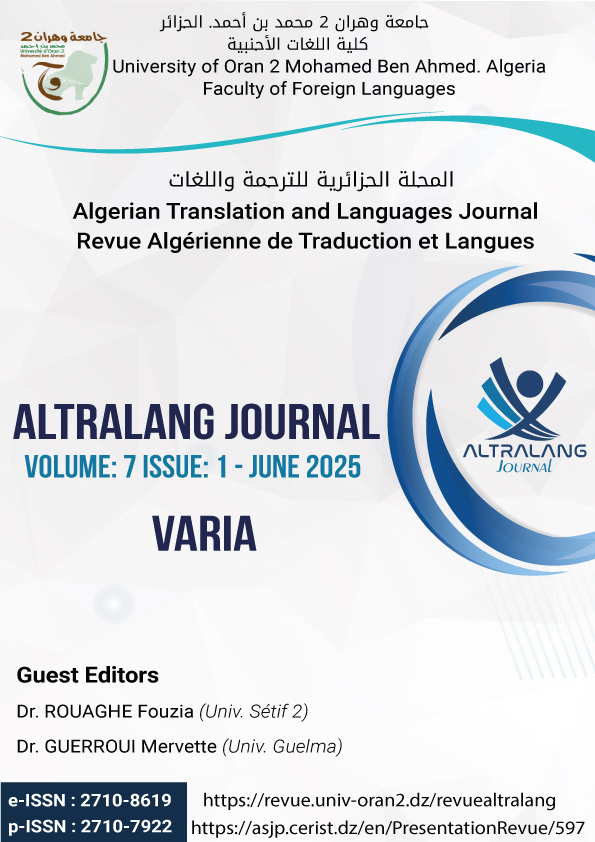Mapping the Linguistic Features of Social Etiquette in Surah An-Nur: A Comparative Corpus Linguistics Study
Main Article Content
Abstract
The Qurʾān is a religious text that has undergone different interpretations across various languages and periods. Despite these variations, the Qurʾān's linguistic devices and rhetorical patterns convey profound meanings that can promote mutual understanding among people of different backgrounds. This article examines the linguistic features employed to convey social etiquette in Surah An-Nur and its English translation. Using comparative corpus linguistics, the study examines the morpho-syntactic structure of the two versions of Surah An-Nur. It demonstrates how they address social issues and ethical codes in the Muslim community. The results of the study reveal variations in the use and distribution of linguistic features across the two corpora. However, the analysis shows that the intricate network of linguistic choices in each corpus plays a crucial role in bridging the gap between expressing social norms in the Arabic corpus and upholding their significance in the English corpus.
Article Details

This work is licensed under a Creative Commons Attribution 4.0 International License.
LICENSE: This work is licensed under a Creative Commons CC BY 4.0 license
References
• Alashqar, A. M. (2012). Proceedings of the 8th International Conference on informatics and Systems (INFOS). IEEE.
• Altarabin, M. (2019). Basics of translations: A textbook for Arab university students. Cambridge Scholars Publishing.
• Barashi, A.S. (2005). Arabic collocations: Implication for translation (Unpublished PhD Thesis). University of Western Sydney.
• Bentrcia, R., Zidat, S., & Marir, F. (2018). Extracting semantic relations from the Quranic Arabic based on Arabic conjunctive patterns. Journal of King Saud University Computer and Information Sciences, 30 (3), 382-390.
• Breedlove, C. (2018). Arabic and English sentence patterns: A comparative guide. Portland State University.
• Chesterman, A. (2000). A casual model for translation studies. In M. Olohan (Ed.), Intercultural faultlines (pp. 15-27). St Jerome Publishing.
• Chomsky, N. (1966). Cartesian linguistics. A Chapter in the History of Rationalist Thought. Harper and Row.
• Dror, J., Dudu, S., Rafi, T., & Shuly, W. (2004). Morphological analysis of the Qur’an. Literary and Linguistic Computing, 19 (4), 431–452.
• Dukes, K. and Habash, N. 5 (Eds.). (2010). Presented at Proceedings of LREC 2010, Seventh International Conference on Language Resources and Evaluation. ELRA.
• Gumperz, J. (1982). Discourse strategies. Cambridge University Press.
• Itmeizeh, M., J. (2017). Exploring discourse markers in the noble Quran: Some verbal clues that facilitate logical hedging, linguistic interaction and language politeness. International Journal on Studies in English Language and Literature, 5 (12), 1-2.
• Jdetawy, L. F., & Hamzah, M. H. (2020). Linguistic etiquette: A Review from a pragmatic perspective. Technium Social Sciences Journal, 14 (1), 695-717.
• Khajehei, H., & Shakarami, A. (2012). An in-depth linguistic analysis of the thematic connectivity in the holy Quran. Academic Research International, 2(2), 682-695.
• Larrivée, P. (2014). The syntax of pragmatics: The case of presuppositional negatives. Syntaxe & Sémantique, 15(1), 115-137.
• Owens, J. (1988). The foundation of grammar, an introduction to medieval Arabic grammatical theory. Amsterdam: Jhon Benyaminns.
• Rahman, F. (2009). Major themes of the Qur'ān (2nd ed.). The University of Chicago Press.
• Rahayu, S., & Eka, F. (2021). Introduction to English morphology. Samarinda.
• Saeh, B. (2015). The Miraculous Language of the Qurʾān: Evidence of Divine Origin. The International Institute of Islamic Thought.
• Saleem, M., & Dad, K. (2016). Linguistic analysis: the distinctiveness text of the Qur’an. Saudi Journal of Humanities and Social Sciences, 1(1), 32-35.
• Susiawati, W. (Eds.). (2020). Proceedings of the Proceedings of the 5th International Conference on Education in Muslim Society, ICEMS. Jakarta, Indonesia.
• Tzortzis, H. A. (2014). God's testimony: The inimitability and divine authorship of the Qur’an (for non-Arabs or non-Experts of the Arabic Language). SAPIENCE Institute.
• Waad, A., S., & Satti, A., W. (2019). Similarities between Arabic and English morphemes and morphosyntactic features. College Of Basic Education Researches Journal, 15(3), 2165-2174.

1.png)